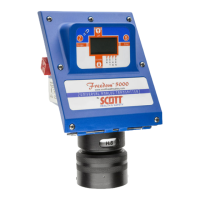43
087-0020 REV E
Troubleshooting
General
Should a problem in the operation of a Freedom™ 5000 occur, the first step is to isolate
the problem to the component which has failed. Generally, the only problems likely to
be encountered are sensor failure, an electronic circuit board failure, or bad connection
between system components, e.g. bad elastomeric pad.
Isolating Sensor Failure
The symptoms of sensor failure are lack of response to gas or unstable transmitter
output. An electronic failure can cause either complete loss of output, an output which is
saturated at 25 mA, or instability. Since the same symptom could be caused by either
type of failure, the easiest way of isolating a problem is to connect a sensor simulator to
the transmitter. A sensor simulator consists of a “dummy sensor” hooked to a length of
2 conductor cable. A sensor simulator may be obtained from Scott Safety (refer to
“Spare Parts” section of manual).
Using the Sensor Simulator
STEP 1 - Remove sens
or and replace it with
the sensor simulator. The simulator will dis-
play 81 followed by 100. The simulator was
arbitrarily set-up as 0-100 ppm H2S.
STEP 2 – Connect a voltage calibrator
to the simulator black and red
wires as show in
Figure 20.
STEP 3 – Connect a DVM (digital volt meter) to the transmitter Test Points. See Figures
7 & 7A.The measuring range should cover 40 – 200 mV.
STEP 4 – Set the voltage calibrator output to 0.250 mV and turn on.
STEP 5 – Using t
he magnetic tip of the screwdriver, touch the “Z” zero point on the
transmitter body for approximately 1 second, then remove the magnet. The
display should read 0 and the DVM should read 40 mV.
Do not attempt to calibrate a
transmitter using the simulator. The
sensor simulator is to be used for
troubleshooting purposes ONLY.
Figure 20 096-2002
The elastomeric pad is often the
source of problem transmitters and can
be easily checked by substituting a
Freedom 5000 Universal Analog Toxic Gas Detector
Instruction Manual

